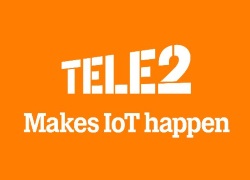Andrew Brown, the executive director of Enterprise and IoT Research at Strategy Analytics, recently spoke with Rami Avidan, the chief executive of Tele2 IoT, to discuss what Tele2 is doing in IoT and how it is addressing the needs of customers, not just in terms of connectivity, but in bringing complete IoT deployments to fruition.
Andrew Brown: Rami, what kind of IoT solutions are customers looking for today and how is Tele2 IoT addressing those needs?
Rami Avidan: When customers are looking at the IoT space, they are looking at creating value from the data that they collect. Very often they are looking for simple integration and flexibility. Whatever they install today needs to be able to scale tomorrow. Customers do not want to be locked into a single vendor or proprietary stack, so they are increasingly looking for over-the-top (OTT) solutions. The real value in the provider they engage with becomes evident not in the initial phase or even the integration phase, but over the lifetime of the project. Increasingly, customers are telling us that cost is secondary to quality of service and that a vendor that can support them with a high level of operational effectiveness as well as technical and business model flexibility is critical to their needs.

In terms of what Tele2 IoT is doing to meet the needs of these customers, it is clear that there are a number of benefits. Firstly our solution is completely agnostic; there is very little which we cannot integrate with in one way or another. We offer a high level of flexibility and scalability, allowing customers to future proof their offerings. We also spend a huge amount of time on operations. Tele2 IoT Servicedesk reached a 90% overall customer satisfaction and a net promoter score (NPS) rating in an independent survey conducted by CFI during between 27 March and 21 April 2017. In the survey, CFI asked our customers about their experience and interaction with Servicedesk and we achieved a 90% customer satisfaction for the second consecutive time. We ensure we have the right level of knowledge about our customers to support them properly. We are also doing a huge amount of integration with other partners, such as IBM, Telit and Microsoft among others.
AB: What companies is Tele2 IoT working with to bring IoT solutions to market? Why is the IoT ecosystem so important when you are a customer and looking at IoT?
RA: I think the first thing you need to address, is why the ecosystem is so important. When you are implementing an IoT solution, you have to work with the provider ecosystem. Typically this used to be a customer/vendor relationship, but this is no longer the case. You need to work with lots of different players, so sometimes you compete and at other times you cooperate. Successful players will be the ones that can position themselves in the ecosystem to work cohesively and transparently with as many different partners as possible, for example, application providers, system integrators, manufacturers, resellers and other service providers. As a company, we need to be agile, flexible, nimble and simple to work with. You also need business models that allow you to work effectively with other companies, underpinned by technology that is simple to integrate as well.
We have partners at many levels in the overall ecosystem – our strategy is based on a partnerdriven go-to-market approach. For example, we are engaged in several operator partnerships, hardware partnerships such as with Telit, and lots of systems integration (SI), value-added reseller (VAR), and application service provider (ASP) partnerships. In the UK, for example, we are doing a lot of focused work in the security vertical with CSL Dualcom.
We’ve also partnered with Axians, which specialises in ICT solutions, together with Cisco and Microsoft to offer a state-of-the-art solution for the machine builders in the Benelux region recently. Now machine builders can remotely monitor their machines, allowing them to get real-time information about all their assets around the globe as well as do remote updates. Machine builders can also analyse information, coming from their machines, making sure that their assets are used in the most efficient way. We have other great examples of successful partnerships that cover everything from Smart AMR (meters) to supply chain monitoring and even smart welding.
AB: What should customers consider when choosing their IoT network?
RA: We are completely technology agnostic and offer services to our customers that are relevant to their requirements. Typically, in our initial engagement with customers, we offer a strategy workshop, where we sit down with them and formulate a plan. This takes into consideration what they are looking to achieve in the short term and in the long term. It may involve different network types, such as cellular, fixed line, nearfield communications (NFC), or a combination of those and others. We will advise them depending on their requirements. It will vary depending on what the customers are looking to achieve. The most important thing is to be focused on helping them extract the value from that data that they capture and to understand what the long term vision should be to extract value from that data.
AB: What is the long-term, single most important aspect in IoT, for customers to think about?
RA: Firstly, over the last seven to 10 months we’ve noticed a marked change in that customers are becoming less focused on the short term cost of the solution during the procurement process, to focusing instead on the quality of service (QoS) long term. That is the right mindset to have in my opinion. It’s important to have a partner who can give assurances about the quality of service long term. The cost of procurement is not going to be the most important thing over the lifetime of the solution.
Secondly, the thing is not to think about choosing a vendor, because customers don’t need vendors, they need partners. There needs to be a partnerdriven approach with business models that allow customers to scale. Clearly there needs to be technology that allows them to achieve their aims and people within the company who can share the pain and success of any solution. Providers also need to be very flexible and able to integrate with multiple providers both from a business model and technology perspective.
In summary, we have lots of different business model engagements. Customers take what they need from our modular offering and there is very little cost to them before they start seeing the benefits. Tele2 IoT is growing at 8-9% month on month, on our underlying recurring business and this is phenomenal growth, driven primarily by our flexibility in business models and modular high performing offerings. We take a horizontal approach, we don’t go in and integrate for customers, but we do that with partners and we do have people who are experts in IoT. This has contributed significantly to our success.










